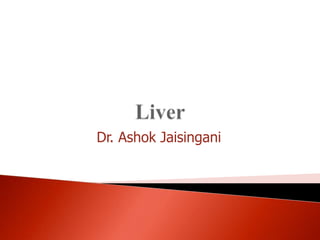
Liver
- 2. Liver is largest organ in the body weighting 1.5 kg in average 70 kg man. The liver parenchyma is entirely covered by thin capsule and by visceral peritoneum on all but the posterior surface of the liver termed as “bare area” The liver is divided in to „right large lobe‟ which is constitute three quarters of liver and „smaller left lobe. Surgical resection of these lobes would be termed as right or left lobectomy.
- 3. The liver has ability to regenerate after the partial resection. There are two anatomical lobes with separate blood supply, bile duct and venous drainage. Liver has dual blood supply with 20% from the hepatic artery and 80% from portal vein.
- 4. Maintaining core body temperature pH balance and correction of lactic acidosis Synthesis of the clotting factors Glucose metabolism, glycolysis and gluconeogenesis. Urea formation from protein catabolism Bilirubin formation from haemoglobin degradation Drug and hormone metabolism Removal of gut endotoxins and foreign antigens
- 5. Viral hepatitis (hepatitis A, B, C, D, E) Drugs reaction [halothane, isoniazid, rifampicin, antidepressant, NSAIDs and valproic acid] Paracetamole overdose Mushroom poisoning Shock and multiorgan failure Acute Budd – Chiari syndrome Wilson‟s Disease Fatty liver disease
- 6. Test Normal Range Bilirubin 5 – 17 µmol/liter Alkaline phosphatase (ALP) 35 – 130 IU/liter Aspartate Transaminase (AST) 5 – 40 IU/liter Alanine Transaminase (ALT) 5 – 40 IU/liter Gama – glutamyl transpeptidase 10 – 48 IU/liter (GGT) Albumin 35 – 50 g/liter Prothrombin time (PT) 12 – 16 sec
- 7. Fluid balance and electrolytes Acid – base balance and blood glucose monitoring Nutrition Renal Function (Haemofiltration) Respiratory Support (Ventilation) Monitoring and treatment of cerebral edema Treat bacterial and fungal infection
- 8. Lethargy Fever Jaundice Protein Catabolism (wasting) Coagulopathy (bruising) Cardiac (Hyperdynamic circulation) Neurological (Hepatic Encephalopathy) Portal hypertension [Ascites, esophageal varices and splenomegaly] Cutaneous [Spider naevi, palmer erythema]
- 9. Imaging Modality Principle Indication Ultrasound Standard first – line investigation Spiral CT Anatomical planning for liver surgery MRI Alternative to spiral CT MRCP First – line non-invasive cholangiography ERCP Imaging the biliary tract, when endoscopic intervention is anticipitated (ductal stones) PTC Biliary tract imaging when ERCP is failed or impossible Angiography To detect vascular involvement by tumour Nuclear medicine To quantify biliary excretion and tumour spread Laparoscopy/laparoscopic To detect peritoneal tumour spread and superficial ultrasound liver metastasis
- 10. Liver injuries are fortunately uncommon because of the position of the liver under the diaphragm where it is protected by the chest wall. When liver injury occurs it is serious and associated with significant morbidity and mortality Liver trauma can be divided into blunt and penetrating liver trauma. Blunt injuries produce contusion, laceration and avulsion injury to the liver, often in association with splenic, mesenteric and renal injury. Penetrating injury such as stab and gunshot wound are often associated with chest or pericardial involvement.
- 11. Remember the associated injuries and at risk group such as 1- Stabbing/gunshot in lower chest or upper abdomen 2- Crush injury with multiple rib fracture Resuscitate the patient (airway, breathing & circulation) Assessment of injury by 1- Spiral CT with contrast 2- Laparotomy if haemodynamically unstable Treatment consist of the 1- Correction of coagulopathy, 2- Suture laceration 3- Resect if vascular Injury 4- Packing if diffuse parenchymal injury
- 12. Intrahepatic haematoma Liver Abscess Bile Collection Biliary Fistulae Hepatic Artery aneurysm Arteriovenous Fistulae Arteriobiliary fistulae Liver Failure
